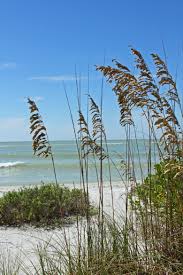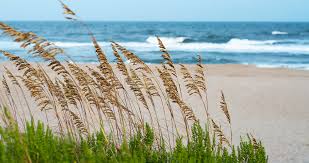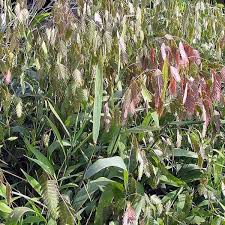Sea Oats, also known by their scientific name Uniola paniculata, are special plants that grow on sandy shores and help keep our beaches safe. They have tall stems with fluffy seed heads that sway in the breeze, making them look like nature’s own decorations.
These plants are like nature’s superheroes because they have strong roots that dig deep into the sand. These roots act like anchors, holding the sand together and stopping it from getting washed away by the waves. This is important because it helps to build up big mounds of sand called dunes. These dunes are like protective walls that keep our beaches from flooding during storms.
But Sea Oats don’t just help protect our beaches. They also give homes to birds, like the seaside sparrow, who make nests among the tall stems. These plants provide food for animals too, like bunnies and deer who like to munch on their leaves. So, Sea Oats are like a buffet and a hotel for animals at the same time!
Taking care of Sea Oats is like taking care of our beach bodyguards. If we don’t look after them, our beaches could get hurt. That’s why people work hard to make sure these plants have enough space to grow and stay healthy.
So, next time you visit the beach and see those cool tall plants with fluffy tops, you’ll know they’re called Sea Oats, and they’re not just pretty – they’re nature’s helpers, making sure our beaches stay strong and safe for everyone to enjoy.
Read Also: Introduction to Poultry Farming
Growing and Care Guide of Sea Oats

Sea oats (Uniola paniculata) are hardy and versatile grasses that are well-suited for coastal landscapes and dune stabilization. If you’re looking to cultivate these remarkable plants, here’s a comprehensive guide to help you successfully grow and care for sea oats:
1. Location and Soil: Choose a sunny location for planting sea oats, as they thrive in full sunlight. They are adapted to sandy, well-draining soils commonly found in coastal areas. Ensure the soil is not overly compacted, as good drainage is essential.
2. Planting: Sea oats can be grown from seeds or established plants. If planting seeds, sow them in the fall to allow for natural stratification over the winter. Plant them at a depth of about half an inch. Water the seeds lightly and keep the soil consistently moist until germination occurs.
3. Watering: Once established, sea oats are relatively drought-tolerant. Water them regularly during the first growing season to help their roots develop. Afterward, they should be able to survive on natural rainfall.
4. Pruning and Maintenance: Sea oats generally require minimal pruning. Remove dead or damaged leaves in the spring to encourage new growth. If the plant becomes too dense, thin out the clumps to improve air circulation.
5. Fertilizing: Sea oats are adapted to nutrient-poor soils, so excessive fertilization is not necessary. A light application of a balanced fertilizer in the spring can promote healthy growth. Avoid high-nitrogen fertilizers, as they can encourage excessive foliage growth at the expense of plume production.
6. Propagation: Propagating sea oats is best done through division. In early spring, carefully dig up mature plants and divide the clumps, ensuring each division has sufficient roots. Replant the divisions at the appropriate spacing.
7. Pests and Diseases: Sea oats are generally resistant to most pests and diseases. However, keeping the plant healthy through proper care and maintenance will help prevent any potential issues.
8. Wildlife Habitat: One of the unique benefits of sea oats is their ability to attract and provide habitat for various wildlife species, especially birds. Consider incorporating sea oats into your landscape to create a welcoming environment for local wildlife.
9. Coastal Protection: Planting sea oats on sand dunes and coastal areas can help stabilize the soil and prevent erosion. Their extensive root systems act as natural anchors, holding the sand in place against wind and water forces.
10. Legal Considerations: Before planting sea oats, especially in coastal areas, check with local authorities or conservation organizations to ensure compliance with any regulations or guidelines that may be in place to protect sensitive coastal ecosystems.
In addition, growing and caring for sea oats (Uniola paniculata) can be a rewarding endeavor, contributing to both the aesthetic beauty of your landscape and the protection of coastal environments. With proper attention to location, soil, watering, and maintenance, you can enjoy the benefits of these remarkable grasses while promoting the health of your local ecosystem.
Importance of Sea Oats

Here are five key importance of sea oats (Uniola paniculata):
1. Erosion Control: Sea oats play a vital role in stabilizing coastal sand dunes and preventing erosion. Their extensive root systems bind the sand together, acting as a natural barrier against the forces of wind and water. This protection is crucial for maintaining the integrity of coastal landscapes and safeguarding nearby properties.
2. Habitat for Wildlife: Sea oats provide essential habitat and nesting sites for a variety of wildlife species, including birds and insects. These grasses create sheltered areas for animals to rest, feed, and reproduce, contributing to the overall biodiversity of coastal ecosystems.
3. Biodiversity Support: The presence of sea oats helps maintain a diverse range of plant and animal species in coastal environments. By stabilizing sand dunes and creating favorable microclimates, sea oats contribute to the survival of various native plants and animals that depend on these habitats.
4. Beach Preservation: Healthy stands of sea oats contribute to the preservation of sandy beaches, which are popular destinations for recreation and tourism. By preventing erosion and maintaining the structure of sand dunes, sea oats indirectly support the long-term health and attractiveness of coastal areas.
5. Climate Resilience: Sea oats contribute to climate resilience by helping to mitigate the impacts of storms and rising sea levels. Their role in stabilizing dunes and protecting coastlines can reduce the severity of erosion and flooding during extreme weather events, providing a buffer that supports community resilience.
In essence, sea oats serve as ecological superheroes of coastal regions, offering multiple benefits that extend beyond their aesthetic appeal. Their impact on erosion control, wildlife habitat, biodiversity, beach preservation, and climate resilience highlights their crucial importance in maintaining the health and functionality of coastal ecosystems.
Read Also: 9 Ways to Fatten Up your Pigs the Right Way
Northern Sea Oats

Northern Sea Oats (Chasmanthium latifolium) is a resilient and attractive grass that adds a touch of elegance to gardens and landscapes across various regions. With its unique appearance, adaptability, and low-maintenance requirements, this native grass has gained popularity among gardeners and homeowners alike.
Northern Sea Oats are known for their distinctive flat, bamboo-like stems and gracefully arching seed heads that resemble flattened oat spikes. These seed heads start as green in color, transitioning to bronze or copper hues as they mature. The grass can reach a height of 2 to 4 feet, creating a gentle swaying movement that adds movement and texture to any planting area.
One of the remarkable features of Northern Sea Oats is its adaptability to various growing conditions. It thrives in both full sun and partial shade, making it a versatile choice for different areas in your landscape. It can also tolerate a range of soil types, from moist to moderately dry, and is well-suited for rain gardens or areas with occasional flooding.
Northern Sea Oats are a delight for those who prefer low-maintenance landscaping. Once established, these grasses require minimal care. They are relatively drought-tolerant, making them suitable for water-wise gardens. While they can spread, they are not invasive, and their growth can be easily managed by dividing clumps every few years to maintain their desired size.
Beyond its aesthetic appeal, Northern Sea Oats provide valuable habitat and food sources for wildlife. Birds, such as sparrows and finches, are particularly drawn to the seeds produced by the grass. These seeds are an important winter food source and can attract a variety of avian visitors to your garden.
Northern Sea Oats can be used in a range of landscaping scenarios. They make beautiful border plants, adding a soft and naturalistic edge to pathways or flower beds. Planted en masse, they can create a stunning visual display and provide a soothing, rustling sound when the wind passes through their seed heads. These grasses also work well in rain gardens, where their adaptability to wet conditions can help manage excess water.
In conclusion, Northern Sea Oats (Chasmanthium latifolium) offer a combination of visual appeal, adaptability, and ease of care that make them a desirable addition to any landscape. Their unique appearance, versatility, and ability to support wildlife make them a charming and environmentally friendly choice for gardens, whether you’re looking to enhance the beauty of your outdoor space or contribute to the well-being of local ecosystems.
Read Also: How To Generate Money From liquid Wastes
